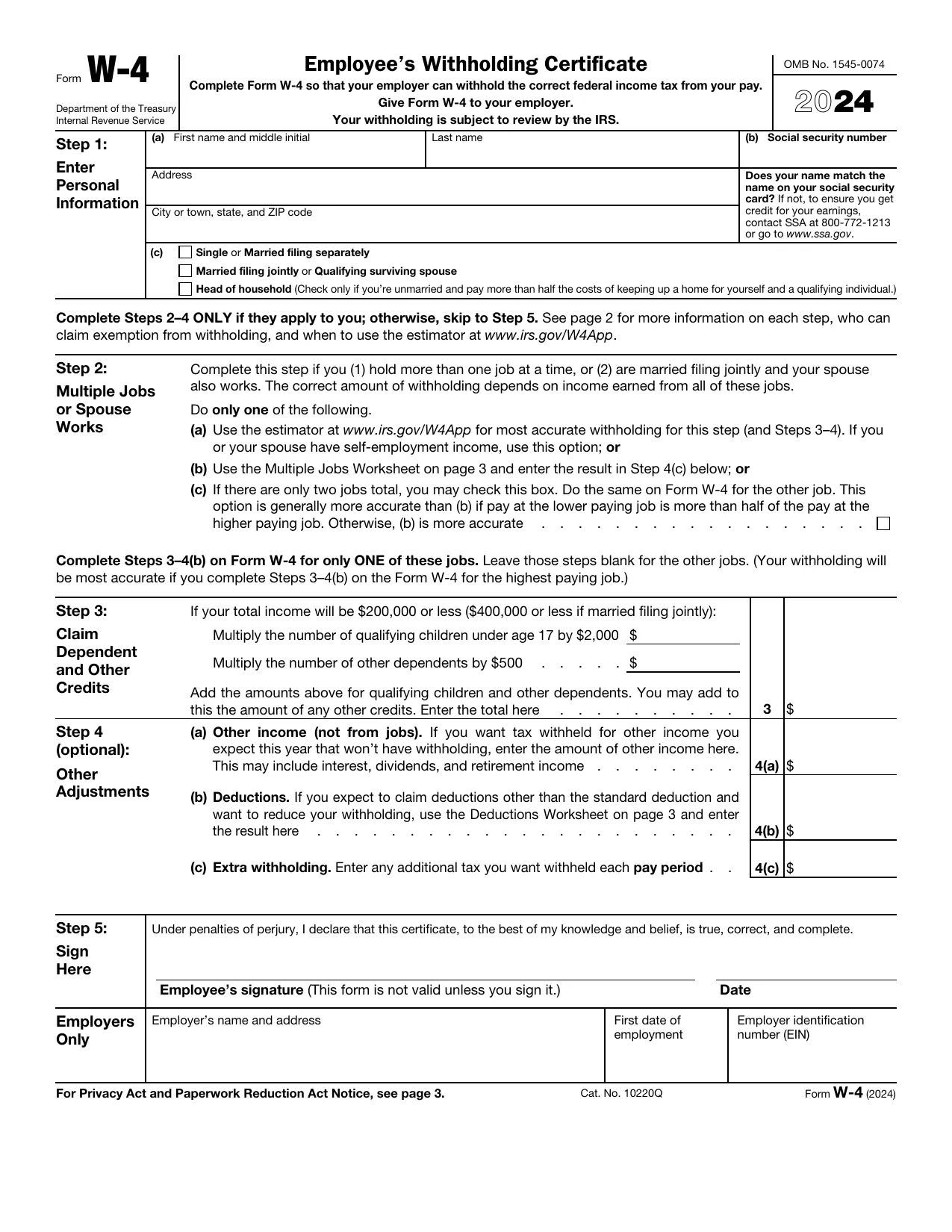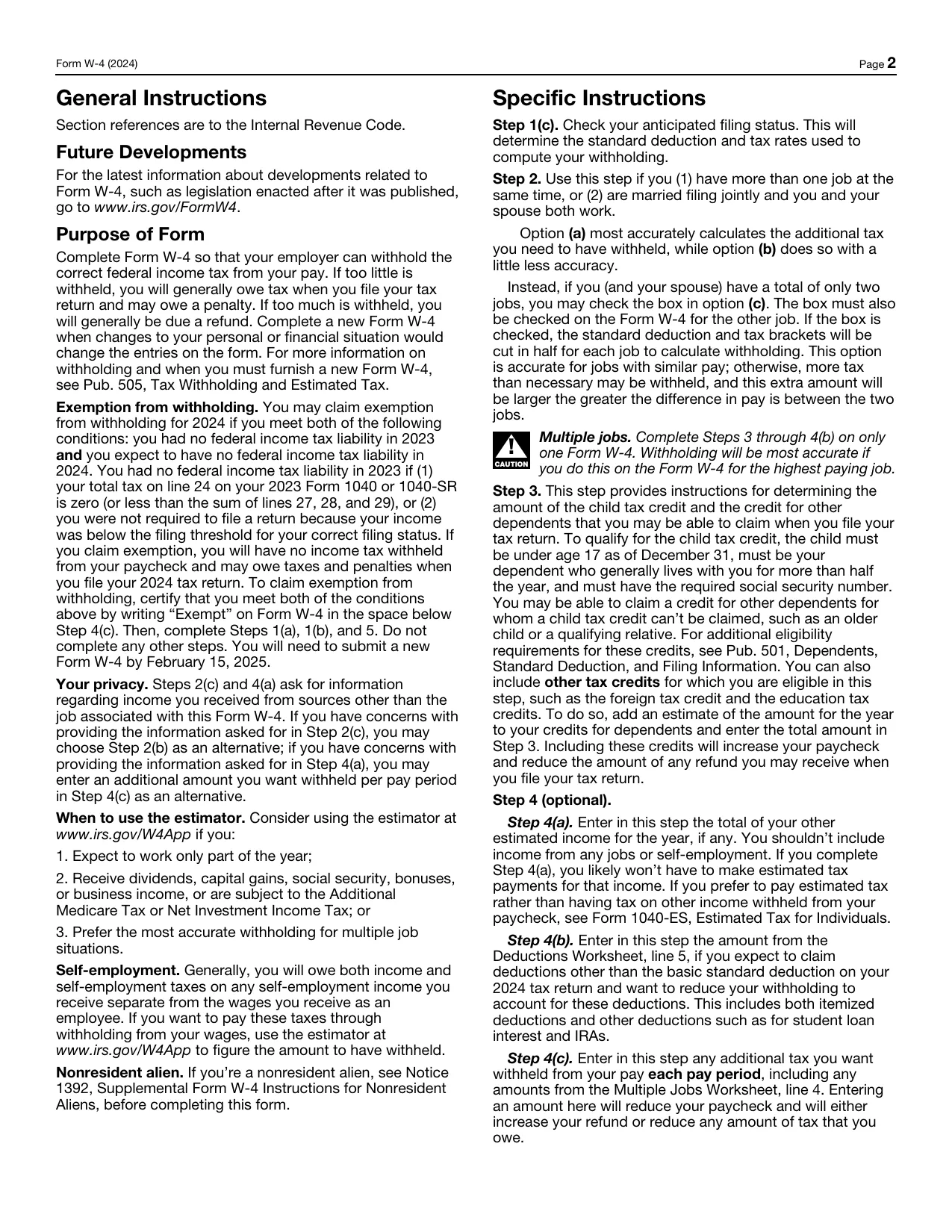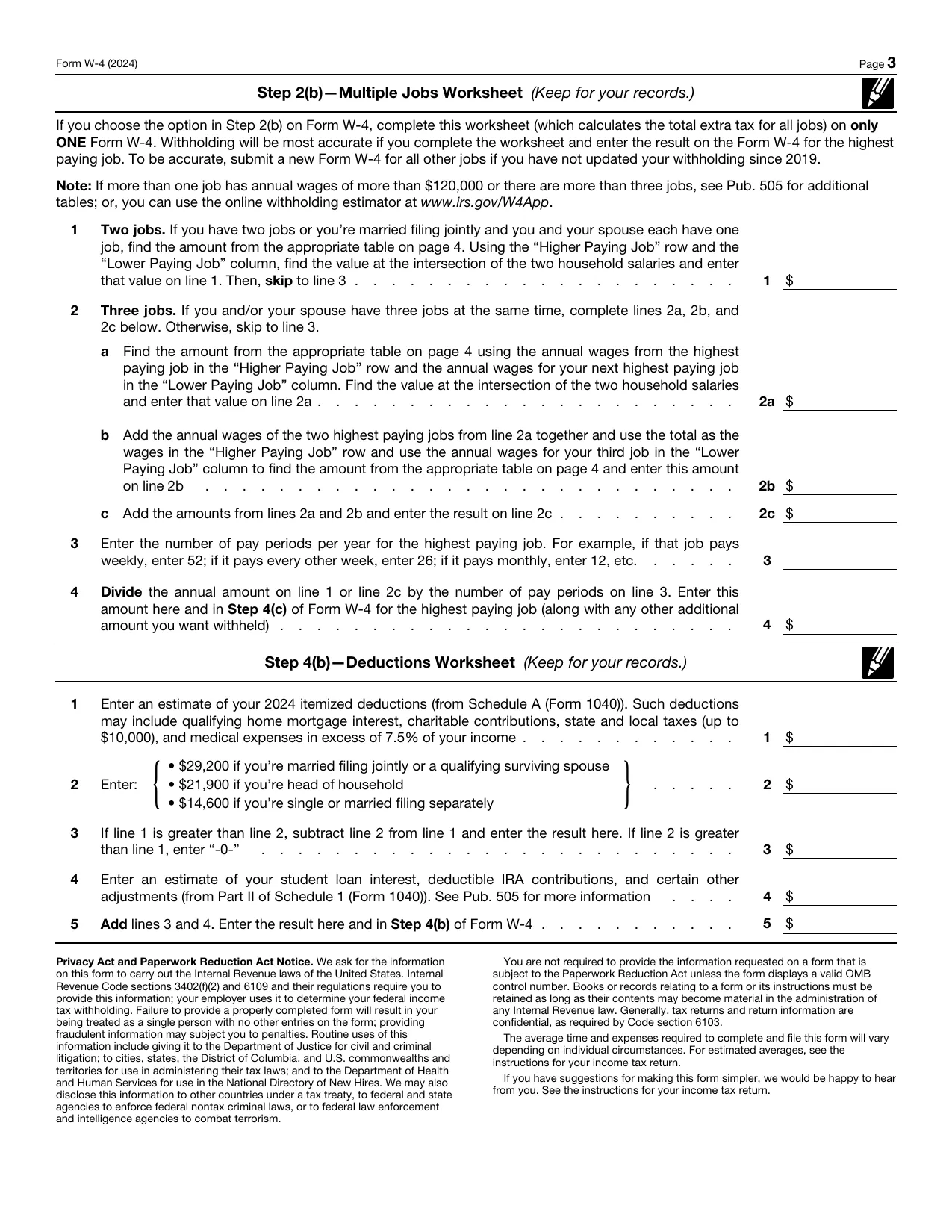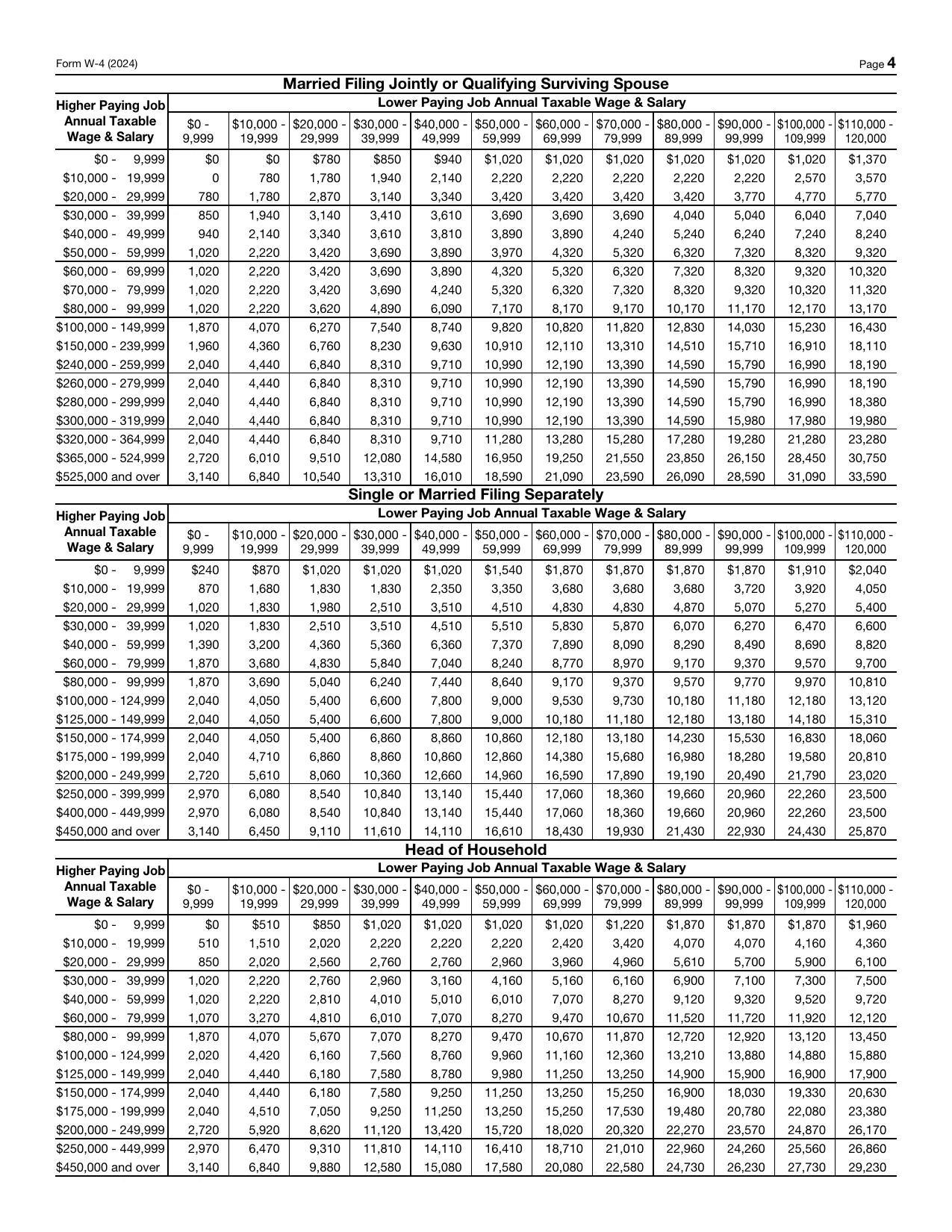Form W-4 2024 - Fill, Sign Online, Download & Print - No Signup
Form
W-4
Department of the Treasury
Internal Revenue Service
Employee’s Withholding Certificate
Complete Form W-4 so that your employer can withhold the correct federal income tax from your pay.
Give Form W-4 to your employer.
Your withholding is subject to review by the IRS.
OMB No. 1545-0074
20
24
Step 1:
Enter
Personal
Information
(a)
First name and middle initial
Last name
Address
City or town, state, and ZIP code
(b) Social security number
Does your name match the
name on your social security
card?
If not, to ensure you get
credit for your earnings,
contact SSA at 800-772-1213
or go to
www.ssa.gov
.
(c)
Single
or
Married filing separately
Married filing jointly
or
Qualifying surviving spouse
Head of household
(Check only if you’re unmarried and pay more than half the costs of keeping up a home for yourself and a qualifying individual.)
Complete Steps 2–4 ONLY if they apply to you; otherwise, skip to Step 5.
See page 2 for more information on each step, who can
claim exemption from withholding, and when to use the estimator at
www.irs.gov/W4App
.
Step 2:
Multiple Jobs
or Spouse
Works
Complete this step if you (1) hold more than one job at a time, or (2) are married filing jointly and your spouse
also works. The correct amount of withholding depends on income earned from all of these jobs.
Do
only one
of the following.
(a)
Use the estimator at
www.irs.gov/W4App
for most accurate withholding for this step (and Steps 3–4). If you
or your spouse have self-employment income, use this option;
or
(b)
Use the Multiple Jobs Worksheet on page 3 and enter the result in Step 4(c) below;
or
(c)
If there are only two jobs total, you may check this box. Do the same on Form W-4 for the other job. This
option is generally more accurate than (b) if pay at the lower paying job is more than half of the pay at the
higher paying job. Otherwise, (b) is more accurate
.
.
.
.
.
.
.
.
.
.
.
.
.
.
.
.
.
.
Complete Steps 3–4(b) on Form W-4 for only ONE of these jobs.
Leave those steps blank for the other jobs. (Your withholding will
be most accurate if you complete Steps 3–4(b) on the Form W-4 for the highest paying job.)
Step 3:
Claim
Dependent
and Other
Credits
If your total income will be $200,000 or less ($400,000 or less if married filing jointly):
Multiply the number of qualifying children under age 17 by $2,000
$
Multiply the number of other dependents
by $500
.
.
.
.
.
$
Add the amounts above for qualifying children and other dependents. You may add to
this the amount of any other credits. Enter the total here
.
.
.
.
.
.
.
.
.
.
3
$
Step 4
(optional):
Other
Adjustments
(a)
Other income (not from jobs).
If you want tax withheld for other income you
expect this year that won’t have withholding, enter the amount of other income here.
This may include interest, dividends, and retirement income .
.
.
.
.
.
.
.
4(a)
$
(b)
Deductions.
If you expect to claim deductions other than the standard deduction and
want to reduce your withholding, use the Deductions Worksheet on page 3 and enter
the result here
.
.
.
.
.
.
.
.
.
.
.
.
.
.
.
.
.
.
.
.
.
.
.
4(b)
$
(c)
Extra withholding.
Enter any additional tax you want withheld each
pay period
.
.
4(c)
$
Step 5:
Sign
Here
Under penalties of perjury, I declare that this certificate, to the best of my knowledge and belief, is true, correct, and complete.
Employee’s signature
(This form is not valid unless you sign it.)
Date
Employers
Only
Employer’s name and address
First date of
employment
Employer identification
number (EIN)
For Privacy Act and Paperwork Reduction Act Notice, see page 3.
Cat. No. 10220Q
Form
W-4
(2024)
Form W-4 (2024)
Page
2
General Instructions
Section references are to the Internal Revenue Code.
Future Developments
For the latest information about developments related to
Form W-4, such as legislation enacted after it was published,
go to
www.irs.gov/FormW4
.
Purpose of Form
Complete Form W-4 so that your employer can withhold the
correct federal income tax from your pay. If too little is
withheld, you will generally owe tax when you file your tax
return and may owe a penalty. If too much is withheld, you
will generally be due a refund. Complete a new Form W-4
when changes to your personal or financial situation would
change the entries on the form. For more information on
withholding and when you must furnish a new Form W-4,
see Pub. 505, Tax Withholding and Estimated Tax.
Exemption from withholding.
You may claim exemption
from withholding for 2024 if you meet both of the following
conditions: you had no federal income tax liability in 2023
and
you expect to have no federal income tax liability in
2024. You had no federal income tax liability in 2023 if (1)
your total tax on line 24 on your 2023 Form 1040 or 1040-SR
is zero (or less than the sum of lines 27, 28, and 29), or (2)
you were not required to file a return because your income
was below the filing threshold for your correct filing status. If
you claim exemption, you will have no income tax withheld
from your paycheck and may owe taxes and penalties when
you file your 2024 tax return. To claim exemption from
withholding, certify that you meet both of the conditions
above by writing “Exempt” on Form W-4 in the space below
Step 4(c). Then, complete Steps 1(a), 1(b), and 5. Do not
complete any other steps. You will need to submit a new
Form W-4 by February 15, 2025.
Your privacy.
Steps 2(c) and 4(a) ask for information
regarding income you received from sources other than the
job associated with this Form W-4. If you have concerns with
providing the information asked for in Step 2(c), you may
choose Step 2(b) as an alternative; if you have concerns with
providing the information asked for in Step 4(a), you may
enter an additional amount you want withheld per pay period
in Step 4(c) as an alternative.
When to use the estimator.
Consider using the estimator at
www.irs.gov/W4App
if you:
1. Expect to work only part of the year;
2. Receive dividends, capital gains, social security, bonuses,
or business income, or are subject to the Additional
Medicare Tax or Net Investment Income Tax; or
3. Prefer the most accurate withholding for multiple job
situations.
Self-employment.
Generally, you will owe both income and
self-employment taxes on any self-employment income you
receive separate from the wages you receive as an
employee. If you want to pay these taxes through
withholding from your wages, use the estimator at
www.irs.gov/W4App
to figure the amount to have withheld.
Nonresident alien.
If you’re a nonresident alien, see Notice
1392, Supplemental Form W-4 Instructions for Nonresident
Aliens, before completing this form.
Specific Instructions
Step 1(c).
Check your anticipated filing status. This will
determine the standard deduction and tax rates used to
compute your withholding.
Step 2.
Use this step if you (1) have more than one job at the
same time, or (2) are married filing jointly and you and your
spouse both work.
Option
(a)
most accurately calculates the additional tax
you need to have withheld, while option
(b)
does so with a
little less accuracy.
Instead, if you (and your spouse) have a total of only two
jobs, you may check the box in option
(c)
. The box must also
be checked on the Form W-4 for the other job. If the box is
checked, the standard deduction and tax brackets will be
cut in half for each job to calculate withholding. This option
is accurate for jobs with similar pay; otherwise, more tax
than necessary may be withheld, and this extra amount will
be larger the greater the difference in pay is between the two
jobs.
▲
!
CAUTION
Multiple jobs.
Complete Steps 3 through 4(b) on only
one Form W-4. Withholding will be most accurate if
you do this on the Form W-4 for the highest paying job.
Step 3.
This step provides instructions for determining the
amount of the child tax credit and the credit for other
dependents that you may be able to claim when you file your
tax return. To qualify for the child tax credit, the child must
be under age 17 as of December 31, must be your
dependent who generally lives with you for more than half
the year, and must have the required social security number.
You may be able to claim a credit for other dependents for
whom a child tax credit can’t be claimed, such as an older
child or a qualifying relative. For additional eligibility
requirements for these credits, see Pub. 501, Dependents,
Standard Deduction, and Filing Information. You can also
include
other tax credits
for which you are eligible in this
step, such as the foreign tax credit and the education tax
credits. To do so, add an estimate of the amount for the year
to your credits for dependents and enter the total amount in
Step 3. Including these credits will increase your paycheck
and reduce the amount of any refund you may receive when
you file your tax return.
Step 4 (optional).
Step 4(a).
Enter in this step the total of your other
estimated income for the year, if any. You shouldn’t include
income from any jobs or self-employment. If you complete
Step 4(a), you likely won’t have to make estimated tax
payments for that income. If you prefer to pay estimated tax
rather than having tax on other income withheld from your
paycheck, see Form 1040-ES, Estimated Tax for Individuals.
Step 4(b).
Enter in this step the amount from the
Deductions Worksheet, line 5, if you expect to claim
deductions other than the basic standard deduction on your
2024 tax return and want to reduce your withholding to
account for these deductions. This includes both itemized
deductions and other deductions such as for student loan
interest and IRAs.
Step 4(c).
Enter in this step any additional tax you want
withheld from your pay
each pay period
,
including any
amounts from the Multiple Jobs Worksheet, line 4. Entering
an amount here will reduce your paycheck and will either
increase your refund or reduce any amount of tax that you
owe.
Form W-4 (2024)
Page
3
Step 2(b)—Multiple Jobs Worksheet
(Keep for your records.)
If you choose the option in Step 2(b) on Form W-4, complete this worksheet (which calculates the total extra tax for all jobs) on
only
ONE
Form W-4. Withholding will be most accurate if you complete the worksheet and enter the result on the Form W-4 for the highest
paying job. To be accurate, submit a new Form W-4 for all other jobs if you have not updated your withholding since 2019.
Note:
If more than one job has annual wages of more than $120,000 or there are more than three jobs, see Pub. 505 for additional
tables; or, you can use the online withholding estimator at
www.irs.gov/W4App
.
1
Two jobs.
If you have two jobs or you’re married filing jointly and you and your spouse each have one
job, find the amount from the appropriate table on page 4. Using the “Higher Paying Job” row and the
“Lower Paying Job” column, find the value at the intersection of the two household salaries and enter
that value on line 1. Then,
skip
to line 3 .
.
.
.
.
.
.
.
.
.
.
.
.
.
.
.
.
.
.
.
.
1
$
2
Three jobs.
If you and/or your spouse have three jobs at the same time, complete lines 2a, 2b, and
2c below. Otherwise, skip to line 3.
a
Find the amount from the appropriate table on page 4 using the annual wages from the highest
paying job in the “Higher Paying Job” row and the annual wages for your next highest paying job
in the “Lower Paying Job” column. Find the value at the intersection of the two household salaries
and enter that value on line 2a .
.
.
.
.
.
.
.
.
.
.
.
.
.
.
.
.
.
.
.
.
.
.
2a
$
b
Add the annual wages of the two highest paying jobs from line 2a together and use the total as the
wages in the “Higher Paying Job” row and use the annual wages for your third job in the “Lower
Paying Job” column to find the amount from the appropriate table on page 4 and enter this amount
on line 2b
.
.
.
.
.
.
.
.
.
.
.
.
.
.
.
.
.
.
.
.
.
.
.
.
.
.
.
.
.
2b
$
c
Add the amounts from lines 2a and 2b and enter the result on line 2c .
.
.
.
.
.
.
.
.
.
2c
$
3
Enter the number of pay periods per year for the highest paying job. For example, if that job pays
weekly, enter 52; if it pays every other week, enter 26; if it pays monthly, enter 12, etc.
.
.
.
.
.
3
4
Divide
the annual amount on line 1 or line 2c by the number of pay periods on line 3. Enter this
amount here and in
Step 4(c)
of Form W-4 for the highest paying job (along with any other additional
amount you want withheld) .
.
.
.
.
.
.
.
.
.
.
.
.
.
.
.
.
.
.
.
.
.
.
.
.
4
$
Step 4(b)—Deductions Worksheet
(Keep for your records.)
1
Enter an estimate of your 2024 itemized deductions (from Schedule A (Form 1040)). Such deductions
may include qualifying home mortgage interest, charitable contributions, state and local taxes (up to
$10,000), and medical expenses in excess of 7.5% of your income .
.
.
.
.
.
.
.
.
.
.
.
1
$
2
Enter:
{
• $29,200 if you’re married filing jointly or a qualifying surviving spouse
• $21,900 if you’re head of household
• $14,600 if you’re single or married filing separately
}
.
.
.
.
.
2
$
3
If line 1 is greater than line 2, subtract line 2 from line 1 and enter the result here. If line 2 is greater
than line 1, enter “-0-”
.
.
.
.
.
.
.
.
.
.
.
.
.
.
.
.
.
.
.
.
.
.
.
.
.
.
3
$
4
Enter an estimate of your student loan interest, deductible IRA contributions, and certain other
adjustments (from Part II of Schedule 1 (Form 1040)). See Pub. 505 for more information
.
.
.
.
4
$
5
Add
lines 3 and 4. Enter the result here and in
Step 4(b)
of Form W-4 .
.
.
.
.
.
.
.
.
.
.
5
$
Privacy Act and Paperwork Reduction Act Notice.
We ask for the information
on this
form to carry out the Internal Revenue laws of the United States. Internal
Revenue Code
sections 3402(f)(2) and 6109 and their regulations require you to
provide this
information; your employer uses it to determine your federal income
tax withholding.
Failure to provide a properly completed form will result in your
being treated as a single
person with no other entries on the form; providing
fraudulent information may
subject you to penalties. Routine uses of this
information include giving it to the
Department of Justice for civil and criminal
litigation; to cities, states, the District of
Columbia, and U.S. commonwealths and
territories for use in administering their tax
laws; and to the Department of Health
and Human Services for use in the National Directory of New Hires. We may also
disclose this
information to other countries under a tax treaty, to federal and state
agencies to
enforce federal nontax criminal laws, or to federal law enforcement
and intelligence
agencies to combat terrorism.
You are not required to provide the information requested on a form that is
subject to the Paperwork Reduction Act unless the form displays a valid OMB
control number. Books or records relating to a form or its instructions must be
retained as long as their contents may become material in the administration of
any Internal Revenue law. Generally, tax returns and return information are
confidential, as required by Code section 6103.
The average time and expenses required to complete and file this form will vary
depending on individual circumstances. For estimated averages, see the
instructions for your income tax return.
If you have suggestions for making this form simpler, we would be happy to hear
from you. See the instructions for your income tax return.
Form W-4 (2024)
Page
4
Married Filing Jointly or Qualifying Surviving Spouse
Higher Paying Job
Annual Taxable
Wage & Salary
Lower Paying Job Annual Taxable Wage & Salary
$0 -
9,999
$10,000 -
19,999
$20,000 -
29,999
$30,000 -
39,999
$40,000 -
49,999
$50,000 -
59,999
$60,000 -
69,999
$70,000 -
79,999
$80,000 -
89,999
$90,000 -
99,999
$100,000 -
109,999
$110,000 -
120,000
$0 - 9,999
$0
$0
$780
$850
$940
$1,020
$1,020
$1,020
$1,020
$1,020
$1,020
$1,370
$10,000 - 19,999
0
780
1,780
1,940
2,140
2,220
2,220
2,220
2,220
2,220
2,570
3,570
$20,000 - 29,999
780
1,780
2,870
3,140
3,340
3,420
3,420
3,420
3,420
3,770
4,770
5,770
$30,000 - 39,999
850
1,940
3,140
3,410
3,610
3,690
3,690
3,690
4,040
5,040
6,040
7,040
$40,000 - 49,999
940
2,140
3,340
3,610
3,810
3,890
3,890
4,240
5,240
6,240
7,240
8,240
$50,000 - 59,999
1,020
2,220
3,420
3,690
3,890
3,970
4,320
5,320
6,320
7,320
8,320
9,320
$60,000 - 69,999
1,020
2,220
3,420
3,690
3,890
4,320
5,320
6,320
7,320
8,320
9,320
10,320
$70,000 - 79,999
1,020
2,220
3,420
3,690
4,240
5,320
6,320
7,320
8,320
9,320
10,320
11,320
$80,000 - 99,999
1,020
2,220
3,620
4,890
6,090
7,170
8,170
9,170
10,170
11,170
12,170
13,170
$100,000 - 149,999
1,870
4,070
6,270
7,540
8,740
9,820
10,820
11,820
12,830
14,030
15,230
16,430
$150,000 - 239,999
1,960
4,360
6,760
8,230
9,630
10,910
12,110
13,310
14,510
15,710
16,910
18,110
$240,000 - 259,999
2,040
4,440
6,840
8,310
9,710
10,990
12,190
13,390
14,590
15,790
16,990
18,190
$260,000 - 279,999
2,040
4,440
6,840
8,310
9,710
10,990
12,190
13,390
14,590
15,790
16,990
18,190
$280,000 - 299,999
2,040
4,440
6,840
8,310
9,710
10,990
12,190
13,390
14,590
15,790
16,990
18,380
$300,000 - 319,999
2,040
4,440
6,840
8,310
9,710
10,990
12,190
13,390
14,590
15,980
17,980
19,980
$320,000 - 364,999
2,040
4,440
6,840
8,310
9,710
11,280
13,280
15,280
17,280
19,280
21,280
23,280
$365,000 - 524,999
2,720
6,010
9,510
12,080
14,580
16,950
19,250
21,550
23,850
26,150
28,450
30,750
$525,000 and over
3,140
6,840
10,540
13,310
16,010
18,590
21,090
23,590
26,090
28,590
31,090
33,590
Single or Married Filing Separately
Higher Paying Job
Annual Taxable
Wage & Salary
Lower Paying Job Annual Taxable Wage & Salary
$0 -
9,999
$10,000 -
19,999
$20,000 -
29,999
$30,000 -
39,999
$40,000 -
49,999
$50,000 -
59,999
$60,000 -
69,999
$70,000 -
79,999
$80,000 -
89,999
$90,000 -
99,999
$100,000 -
109,999
$110,000 -
120,000
$0 - 9,999
$240
$870
$1,020
$1,020
$1,020
$1,540
$1,870
$1,870
$1,870
$1,870
$1,910
$2,040
$10,000 - 19,999
870
1,680
1,830
1,830
2,350
3,350
3,680
3,680
3,680
3,720
3,920
4,050
$20,000 - 29,999
1,020
1,830
1,980
2,510
3,510
4,510
4,830
4,830
4,870
5,070
5,270
5,400
$30,000 - 39,999
1,020
1,830
2,510
3,510
4,510
5,510
5,830
5,870
6,070
6,270
6,470
6,600
$40,000 - 59,999
1,390
3,200
4,360
5,360
6,360
7,370
7,890
8,090
8,290
8,490
8,690
8,820
$60,000 - 79,999
1,870
3,680
4,830
5,840
7,040
8,240
8,770
8,970
9,170
9,370
9,570
9,700
$80,000 - 99,999
1,870
3,690
5,040
6,240
7,440
8,640
9,170
9,370
9,570
9,770
9,970
10,810
$100,000 - 124,999
2,040
4,050
5,400
6,600
7,800
9,000
9,530
9,730
10,180
11,180
12,180
13,120
$125,000 - 149,999
2,040
4,050
5,400
6,600
7,800
9,000
10,180
11,180
12,180
13,180
14,180
15,310
$150,000 - 174,999
2,040
4,050
5,400
6,860
8,860
10,860
12,180
13,180
14,230
15,530
16,830
18,060
$175,000 - 199,999
2,040
4,710
6,860
8,860
10,860
12,860
14,380
15,680
16,980
18,280
19,580
20,810
$200,000 - 249,999
2,720
5,610
8,060
10,360
12,660
14,960
16,590
17,890
19,190
20,490
21,790
23,020
$250,000 - 399,999
2,970
6,080
8,540
10,840
13,140
15,440
17,060
18,360
19,660
20,960
22,260
23,500
$400,000 - 449,999
2,970
6,080
8,540
10,840
13,140
15,440
17,060
18,360
19,660
20,960
22,260
23,500
$450,000 and over
3,140
6,450
9,110
11,610
14,110
16,610
18,430
19,930
21,430
22,930
24,430
25,870
Head of Household
Higher Paying Job
Annual Taxable
Wage & Salary
Lower Paying Job Annual Taxable Wage & Salary
$0 -
9,999
$10,000 -
19,999
$20,000 -
29,999
$30,000 -
39,999
$40,000 -
49,999
$50,000 -
59,999
$60,000 -
69,999
$70,000 -
79,999
$80,000 -
89,999
$90,000 -
99,999
$100,000 -
109,999
$110,000 -
120,000
$0 - 9,999
$0
$510
$850
$1,020
$1,020
$1,020
$1,020
$1,220
$1,870
$1,870
$1,870
$1,960
$10,000 - 19,999
510
1,510
2,020
2,220
2,220
2,220
2,420
3,420
4,070
4,070
4,160
4,360
$20,000 - 29,999
850
2,020
2,560
2,760
2,760
2,960
3,960
4,960
5,610
5,700
5,900
6,100
$30,000 - 39,999
1,020
2,220
2,760
2,960
3,160
4,160
5,160
6,160
6,900
7,100
7,300
7,500
$40,000 - 59,999
1,020
2,220
2,810
4,010
5,010
6,010
7,070
8,270
9,120
9,320
9,520
9,720
$60,000 - 79,999
1,070
3,270
4,810
6,010
7,070
8,270
9,470
10,670
11,520
11,720
11,920
12,120
$80,000 - 99,999
1,870
4,070
5,670
7,070
8,270
9,470
10,670
11,870
12,720
12,920
13,120
13,450
$100,000 - 124,999
2,020
4,420
6,160
7,560
8,760
9,960
11,160
12,360
13,210
13,880
14,880
15,880
$125,000 - 149,999
2,040
4,440
6,180
7,580
8,780
9,980
11,250
13,250
14,900
15,900
16,900
17,900
$150,000 - 174,999
2,040
4,440
6,180
7,580
9,250
11,250
13,250
15,250
16,900
18,030
19,330
20,630
$175,000 - 199,999
2,040
4,510
7,050
9,250
11,250
13,250
15,250
17,530
19,480
20,780
22,080
23,380
$200,000 - 249,999
2,720
5,920
8,620
11,120
13,420
15,720
18,020
20,320
22,270
23,570
24,870
26,170
$250,000 - 449,999
2,970
6,470
9,310
11,810
14,110
16,410
18,710
21,010
22,960
24,260
25,560
26,860
$450,000 and over
3,140
6,840
9,880
12,580
15,080
17,580
20,080
22,580
24,730
26,230
27,730
29,230




